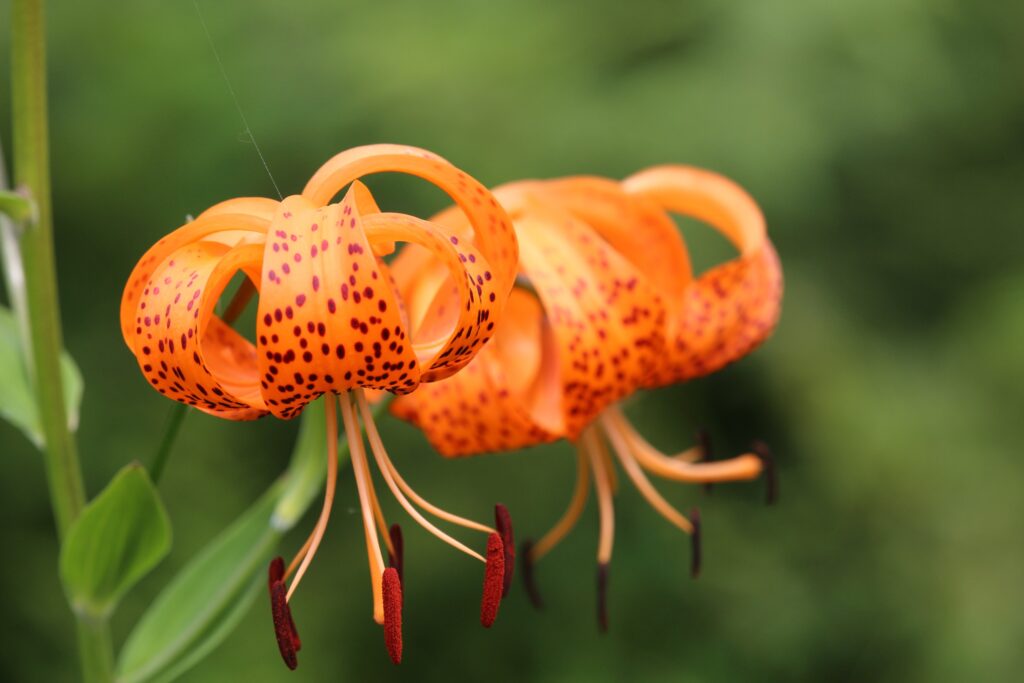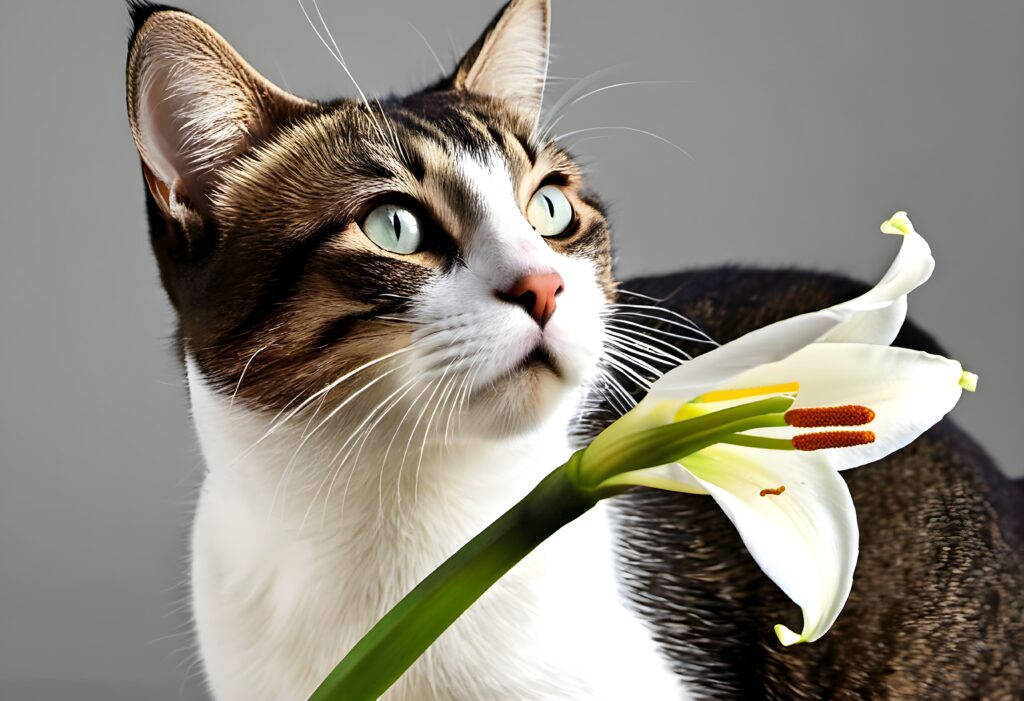Imagine this: you’re hosting Easter dinner, the table is set, the aroma of a feast fills the air, and your home is brimming with warmth and laughter. In the midst of the celebration, a guest arrives, holding a bouquet of vibrant lilies, a symbol of the season’s joy.
Appreciating the gesture, you place them in a vase, adding a touch of spring’s beauty to your festive décor. As the evening unfolds, your attention is fully on your guests, sharing stories and making memories.
Unbeknownst to you, amidst the festivity, your curious cat finds its way to the newly placed bouquet. Attracted by the allure of the fresh flowers, they begin to investigate, sniffing the flowers and perhaps taking a nibble.
Perfectly innocent and normal behavior, and no real harm done, right? WRONG! Your Easter dinner just became a medical emergency!
This scenario, seemingly innocent, unfolds in homes around the world, posing a question that challenges our common perceptions: How often do we put our feline friends at risk with our holiday traditions?
Real Stories, Real Impact: A Vital Lesson from Basil and Cricket
A recent post by Reddit user Specialist_Ad340 highlights the overlooked danger lilies pose to pets.
Specialist_Ad340’s ordeal began with an innocent purchase of a bouquet of lilies, unaware of the peril these plants represented. The situation quickly escalated when Basil, a 1-year-old black and white male cat, was found with lily pollen on his face and mouth.
While they did not elaborate on how they became aware of lilies’ toxic threat, the realization came in time for Specialist_Ad340 to rush Basil and his companion Cricket, a 2-year-old ginger male, to the vet where both received prompt treatment.
Though it wasn’t certain that Cricket had also been exposed, his owner took no chances. Given the severe risks associated with lily exposure in cats, there is no room for speculation. Cricket received the same life-saving treatment as Basil.
Fortunately, in this case the owner’s quick action saved the lives of both cats. Other cat owners are not always so lucky, losing their precious fur babies to the poison of the lily.
While this story has a happy ending for Basil and Cricket, it was an expensive lesson for Specialist_Ad340. Besides the emotional toll, the financial costs were significant: they state that their “$4 spent on a pretty little flower turned into a $2k+ vet bill”.
Knowing the Facts: Lilies & Cats are a Deadly Combination
This real-life experience is just one of many cases where innocent curiosity turned into a potentially deadly situation due to lack of awareness.
According to the Pet Poison Helpline, lily toxicity is one of the most severe and potentially life-threatening dangers for cats. This includes all lilies in the Lilium and Hemerocallis (daylily) families.
The Easter lily (Lilium longiflorum), also known as the trumpet lily, is among the worst. Even small amounts (such as chewing on a leaf, drinking water from a vase containing lilies, or ingesting a few grains of pollen) can result in severe kidney damage or even death within 72 hours after exposure.

Why Are Lilies So Poisonous to Cats?
The exact toxic compound in lilies responsible for causing kidney failure in cats has not been definitively identified. However, all parts of the lily plant are considered toxic.
Soon after any part of the lily is ingested, damage starts to occur to the kidney epithelial cells. Kidney epithelial cells are the basic functional unit of the kidney, lining the tubules of the kidneys. These tubules play a central role in the kidney’s function, which includes filtering waste products from the blood, regulating electrolyte balance, and managing water reabsorption.
Each of these functions is critical for maintaining the body’s internal balance, known as homeostasis. Damage to these cells can disrupt the kidney’s ability to filter and eliminate waste products effectively.
This disruption can lead to a buildup of toxins in the body, a condition known as uremia. Additionally, damaged epithelial cells can impair the kidney’s ability to regulate electrolyte and fluid balance, leading to issues such as dehydration, electrolyte imbalances, or edema (swelling due to fluid retention).
Depending on the extent of the damage and the kidney’s ability to repair or compensate for the lost function, the effects can range from temporary dysfunction to acute kidney injury and death. Cats that survive may have chronic kidney disease, where the damage is irreversible and progressively worsens over time.

Clinical Signs of Lily Poisoning in Cats
In the first 1 – 3 hours following ingestion, the initial clinical signs can include:
- Vomiting
- Drooling
- Loss of appetite
- Lethargy
These early symptoms reflect gastrointestinal upset and the onset of systemic toxicity. Immediate veterinary care at this point can usually reduce the toxin’s effects and prevent progression to more severe kidney damage.
If not treated quickly, over the next 12 – 30 hours the cat may begin to show more serious clinical signs indicating kidney involvement, such as:
- Increased urination, followed by a decrease in urine production as kidney damage progresses
- Dehydration, evidenced by dry mouth, sunken eyes, and decreased skin elasticity
- Continued vomiting
- Lethargy or depression deepening
- Lack of appetite
These symptoms reflect the worsening impact of the toxin on the cat’s kidneys and the beginning stages of acute kidney failure. If treatment is not started within 18 hours of exposure, permanent kidney damage or failure is almost certain. Untreated cats will die within 3 to 7 days.

Treatment
If a cat is suspected of ingesting lilies, immediate treatment is critical to minimize the risk of kidney damage and increase the chances of recovery. If there is even a suspicion that your cat has been exposed to lilies, do not hesitate. Take your cat to the vet immediately.
Treatment for lily poisoning in cats includes the following:
- Decontamination: If the ingestion was very recent, the vet might induce vomiting to remove as much of the plant material from the stomach as possible. Activated charcoal might also be administered to help absorb any remaining toxins.
- Intravenous Fluids (IV): The mainstay of treatment involves administering IV fluids. This process helps remove toxins from the kidneys by boosting urine production and aids in filtering harmful substances from the blood.
- Monitoring and Supportive Care: The vet will closely monitor your cat’s kidney function through blood tests and urine output. They may also provide supportive care, such as medications to control vomiting and nausea or supplements to support kidney function.
- Observation: After initial treatment, continued observation in a veterinary hospital might be necessary for a few days to ensure the kidneys are functioning properly and to provide further treatment if needed.
Early and aggressive treatment can significantly improve the prognosis for cats poisoned by lilies. Without treatment, the risk of permanent kidney damage or even death is high
Prevention
Preventing lily poisoning in cats is all about being aware and careful. Here’s what you need to know:
- Avoid Lilies: The best way to stop lily poisoning is to not have lilies or other plants that are harmful to cats at home. If you’re unsure about a plant, do a quick online search or ask a vet. Most fig plants, for example, are toxic to cats but most homeowners are unaware of this fact.
- Inform Others: Let people who might bring flowers or plants to your home know that lilies are dangerous to your cat. This includes guests, family, and florists.
- Choose Safe Plants: Pick cat-friendly plants and flowers. There are many beautiful options that won’t harm your pets. Spider plants are common and popular houseplants that are safe to have around cats, for example.
- Keep an Eye Out: Watch your cat, especially around new plants or flowers. Acting fast can prevent them from eating something harmful.
- Be Prepared: Learn the symptoms of lily poisoning and have a plan ready, including the number for the closest emergency vet, in case your cat gets exposed.

Spread the Message: Lilies Kill Cats!
The gravest danger in the battle against lily poisoning in cats isn’t just the toxin itself, but the lack of awareness about this lethal threat. Many cat owners and even lovers of flora are surprisingly uninformed about the risk that lilies pose to our feline friends.
Knowledge and proactive prevention can mean the difference between life and death for countless pets. We encourage you to join us in the essential mission to protect our beloved cats from unintentional harm.
Please share the message “No Lilies for Kitties” far and wide; on social media, with your family and friends, and even in conversations with fellow plant enthusiasts or pet owners.
Spreading awareness is a powerful tool in preventing these tragic incidents and ensuring our pets live long, healthy lives in safety.
Pet Poison Control Centers
- Pet Poison Helpline, 855-764-7661, www.petpoisonhelpline.com
- ASPCA Animal Poison Control Center, 888-426-4435, www.aspca.org/pet-care/animal-poison-control
Disclaimer: This article is intended for informational purposes only, and does not constitute medical advice. Always consult your veterinarian if you have specific concerns about your pet’s health.
Sources
- https://www.fda.gov/animal-veterinary/animal-health-literacy/lovely-lilies-and-curious-cats-dangerous-combination
- https://www.merckvetmanual.com/toxicology/poisonous-plants/houseplants-and-ornamentals-toxic-to-animals
- https://www.petpoisonhelpline.com/uncategorized/paws-on-safety-1-min-pet-clinic-lily-toxicity
[Image credit: All images are used under license or with permission]

